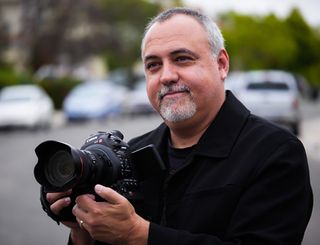Cameras Shoot for Connectivity and Efficiency

As camera manufacturers look toward 2014, they continue to face a number of challenging trends, with market analysts Frost & Sullivan predicting only a 1.4% compound annual growth rate in the business through 2017.
But vendors are also reporting brisk demand for certain types of models, notably ENG cameras with built-in wireless capabilities and large censor digital-cinematography cameras. Here are a few key trends to watch in early 2014, as the industry convenes in Las Vegas for the annual Consumer Electronics Show.
Smaller, Cheaper, Better
“The broadcasters are all looking for lower-cost acquisition equipment so they can get more cameras and people on the street,” says Larry Thorpe, senior fellow at the professional engineering and solutions division of Canon U.S.A., which has brought out the XA20 and XA25 camcorders, each of which weighs less than two pounds—with a lens.
The smaller cameras, which have also been launched by JVC, Sony, Panasonic and others, have seen significant improvements in their CMOS sensors, which have very good low-light capabilities.
Cameras to Keep You Connected
As part of the push to get more cameras in the field, broadcasters are increasingly looking for Internet connectivity built directly into the camera, a feature that JVC, Canon and other manufacturers are now offering.
Broadcasting & Cable Newsletter
The smarter way to stay on top of broadcasting and cable industry. Sign up below
“We are seeing stations starting to use them without a backpack,” says Larry Librach, VP of broadcast and public sector at JVC Professional Products Company, which launched the GY-HM650 with built-in Internet connectivity in 2012. The camera has since been widely adopted by a number of stations. Its connectivity allows stations to share feeds, he adds.
Manufacturers such as Sony and Panasonic have also set up cloud-based production systems that connect cameras to facilities around the world where footage can be edited. This approach “allows customers to upload content and store and share it in the cloud,” says Steve Cooperman, senior product manager for pro video at Panasonic.
Streamlining Workflows
The push to build Internet connectivity into cameras to speed up the process of sending footage back to stations is only one example of how important workflow has become for camera sales, with stations often making their final purchase decision based in part on how well a camcorder fits into the station’s existing workflow.
To help the cause, Grass Valley has launched new base stations and is designing its cameras to feature a modular system so they can be easily updated with new formats via software, reports Klaus Weber, director of product marketing for imaging at Grass Valley. “The setup for a mobile van can take a minute or two rather than a half-hour,” he says.
Getting Up to (Cinema) Speed
As TV and movie producers make the last transition from film to digital, high-end digital cameras with large sensors that provide the great depth of field and high-quality images long demanded by film producers are also much in demand, both for traditional HD and 4K production.
To tap into that market, Canon has launched a Cinema EOS line of cameras with 4K sensors. Their high-end Cinema EOS 500 produces 4K images, but the 4K sensors allow the 300 and 100 cameras to produce much better HD images, Canon’s Thorpe says. That has led to the adoption of the Cinema EOS on scripted TV as well as newsmagazines such as 60 Minutes, he adds.
Shooting for 4K Sales
Amazon announced recently that it will start producing its original series in 4K. That’s only the most recent example of a growing demand for those cameras in high-end movie or TV production. Sony’s F55 camera has been used to shoot shows such as The Blacklist, The Michael J. Fox Show, Community and Masters of Sex in 4K.
In 2014, manufacturers are also expected to launch the first 4K cameras specifically designed for live production. “Our new 4K Varicam will have both a RAW [minimally processed original video] and a live workflow,” says Steve Cooperman, senior product manager for pro video at Panasonic.
The demand for projecting movies at higher frame rates has also led to super-slo-mo 4K cameras for special effects. “If you are projecting at 60 frames per second, then you need a camera that can shoot at 600 to get a 10-times slowdown,” says Rick Robinson, VP of marketing at Vision Research. The company will soon start selling its Phantom Flex camera, which can shoot 4K images at up to 1,000 frames per second.
